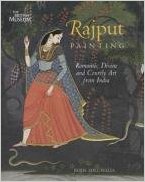Should one judge a book by its cover? By its title? Indeed, one should not and I would hasten to speak out against such a superficial and disrespectful attitude towards books and the great effort that it takes to produce them. Having read Roda Ahluwalia’s book on Rajput painting, however, I feel entitled to say that one does get a good sense of this book from its title and cover. The book’s cover is beautiful, showing a lovely detail from an 18th c Pahari painting showing an abhisarika, a heroine who steals out to meet her lover, undeterred by the dangers of the night. From the cover, we might correctly anticipate the visual feast that lies within the book, whose 113 high-quality reproductions bring us fine images from the Indian painting collections of the British Library and British Museum. The book’s title: Rajput Painting: Romantic, Divine and Courtly Art from India also accurately, alas, suggests that the book will treat its subject in a slightly out-of-date and clichéd way.
The term ‘Rajput Painting’ is used to denote paintings made between 16th-19th centuries for royal and noble patrons in Rajasthan and the lower Himalayas, since the ruling families of most of these kingdoms were of the Rajput caste. The term was coined in 1916 by the great nationalist scholar, Ananda Coomaraswamy in his pioneering book on the subject. Coomarawamy had just scoured the little towns in the region, and with his prescient eye had recognized true quality in paintings that were still unfashionable among the Mughal-obsessed collectors of the day. Most of the extraordinary collection that Co-omaraswamy built is now housed at the Museum of Fine Arts, Boston.
In his book on these paintings, Coomaraswamy took pains to distinguish these paintings from the productions of the Mughal court. ‘Mughal art . . . is of purely aristocratic interest: while that of Rajput painters is universal,’ he said. ‘Rajput art stands to the classic art of India in the same relations as the contemporary vernaculars of Hindustan stand to Sanskrit. . . . Rajput painting . . . emerges as the culture of the whole race, equally shared by kings and peasants.’

